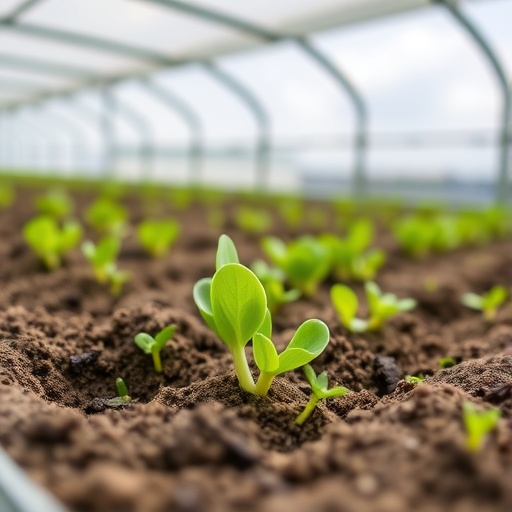The advancement of biofertilizers marks a significant evolution in the agricultural landscape, where traditional single-strain formulations are giving way to more complex synthetic microbial communities, or SynComs. This transformation represents a critical move towards sustainable agricultural practices, providing farmers and researchers with innovative tools to enhance soil health, improve crop yields, and reduce dependency on chemical fertilizers. The research by Singh, Jha, and Pathak (2025) showcases the promise and potential of these synthetic microbial ecosystems, which are poised to revolutionize how we approach crop production and soil management.
Biofertilizers have long been recognized for their ability to enhance nutrient availability and promote plant growth. The conventional use of specific bacterial or fungal strains has yielded beneficial results, yet limitations remain. These single-strain formulations often lack the diversity necessary to adapt to varying environmental conditions, leading to inconsistent performance in field scenarios. Addressing these shortcomings, researchers are turning their attention to the creation of synthetic microbial communities, which aim to harness the synergistic effects of multiple microorganisms working together.
The concept of synthetic microbial communities is a fascinating frontier in agronomy, where the complex interactions between various microbial species can lead to enhanced functionality. By carefully engineering these communities, researchers can create a tailored solution to specific agronomic challenges, improving the resilience of crops against pests and diseases while promoting nutrient uptake. This innovative approach recognizes that plant-microbe interactions are not merely transactional but a dynamic interplay that can be optimized for better agricultural outcomes.
The evolution from single strains to synthetic communities involves understanding the microbiome of the soil, which is teeming with diverse microbial life. Each species plays a unique role in nutrient cycling, disease suppression, and enhancing plant growth. By studying these interactions, scientists can pinpoint which microbial combinations yield the best results for specific crops under varying environmental conditions. This level of customization is what makes SynComs a game changer in the biofertilizer landscape.
One of the key advantages of synthetic communities is their resilience, providing a built-in mechanism to cope with stressors such as drought, poor soil conditions, and pathogen outbreaks. In conventional formulations, the failure of a single microbial strain could lead to reduced efficacy in the field. In contrast, a well-engineered SynCom, with its diverse array of microorganisms, can better withstand environmental fluctuations and retain functionality, providing continuous benefits to the plant host.
Furthermore, the synergistic effects within these microbial communities can enhance nutrient solubilization and mineralization, ensuring that plants have access to essential macronutrients and micronutrients efficiently. This function not only promotes robust growth but also helps optimize overall plant health, paving the way for sustainable farming practices that reduce chemical input and minimize the ecological footprint of agriculture.
As we look to the future, the integration of these advanced biofertilizers into mainstream agricultural practices could lead to a paradigm shift. Farmers could harness the power of synthetic microbial communities not only to boost productivity but also to foster soil health and biodiversity. This holistic approach aligns with the principles of regenerative agriculture, where the focus extends beyond yields to include ecosystem health and sustainability.
Moreover, the path to widespread adoption of SynComs will require a concerted effort among scientists, agronomists, and policymakers. Education and outreach will play a crucial role in overcoming skepticism among farmers accustomed to traditional biofertilization methods. Demonstration projects showcasing successful implementations in the field will help build trust and encourage adoption of these innovative solutions.
In conclusion, the potential of synthetic microbial communities in agriculture is vast and largely untapped. As research continues to unravel the intricacies of microbial interactions and their implications for plant health, we stand on the brink of a significant transformation in how we approach biofertilization. The journey from single-strain formulations to these complex, engineered systems is only just beginning, yet it promises to usher in a new era of sustainable agriculture, safeguarding our food systems for generations to come.
The implications of this research extend far beyond crop yields; they touch on the very fabric of sustainable farming and environmental stewardship. Innovations in biofertilizers are paving the way for the future of agriculture, where farmers can rely on natural processes for productivity, resilience, and environmental well-being.
With this evolution in biofertilizers, the commitment to sustainable agriculture takes center stage, reaffirming the essential role of science in addressing the pressing challenges of food security and environmental degradation. The collaborative efforts between researchers and agronomists are set to shape a new agricultural paradigm where productivity and sustainability coexist in harmony.
As we embark on this journey towards a more sustainable agricultural future, the strides made in understanding and applying synthetic microbial communities will serve as a cornerstone for innovative practices that benefit farmers, consumers, and the planet alike.
Subject of Research: Advanced Biofertilizers and Synthetic Microbial Communities
Article Title: Advancing biofertilizers: the evolution from single-strain formulations to synthetic microbial communities (SynCom) for sustainable agriculture.
Article References: Singh, M., Jha, S., Pathak, D. et al. Advancing biofertilizers: the evolution from single-strain formulations to synthetic microbial communities (SynCom) for sustainable agriculture. Discov. Plants 2, 226 (2025). https://doi.org/10.1007/s44372-025-00318-w
Image Credits: AI Generated
DOI:
Keywords: Biofertilizers, Synthetic Microbial Communities, Sustainable Agriculture, Soil Health, Crop Yields, Environmental Sustainability, Agroecology.
Tags: agricultural research advancementsbiofertilizer evolutionchemical fertilizer reductioncrop yield enhancementenvironmental adaptation in agricultureinnovative agricultural toolsmicrobial ecosystem engineeringmulti-strain biofertilizersplant growth promotionsoil health improvementsustainable agricultural practicessynthetic microbial communities





